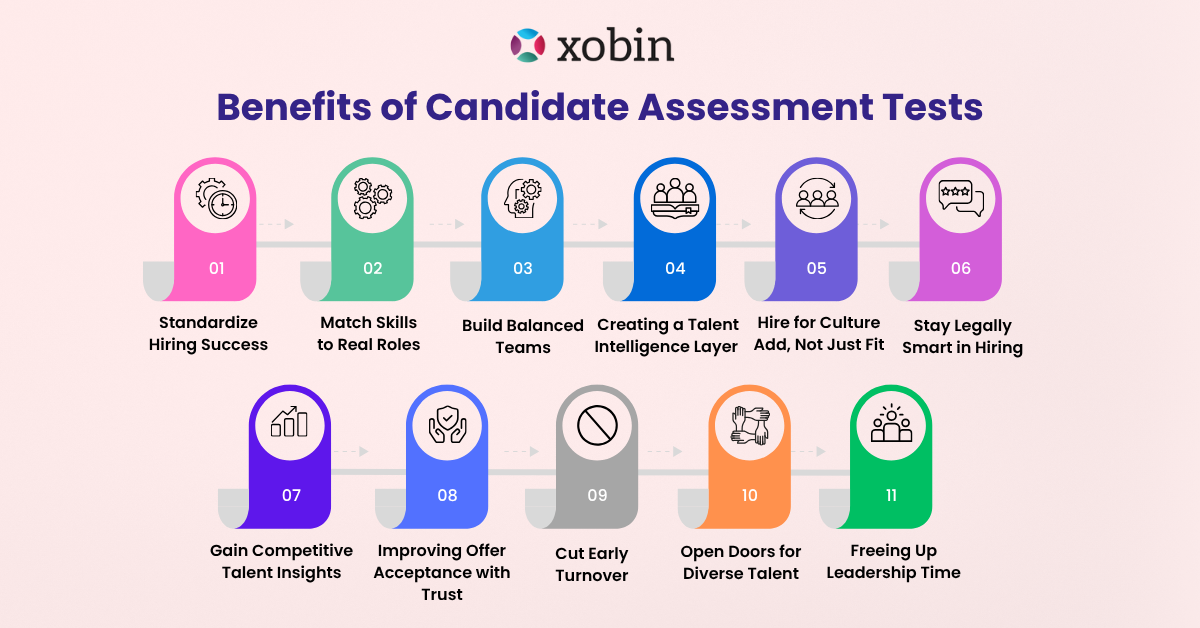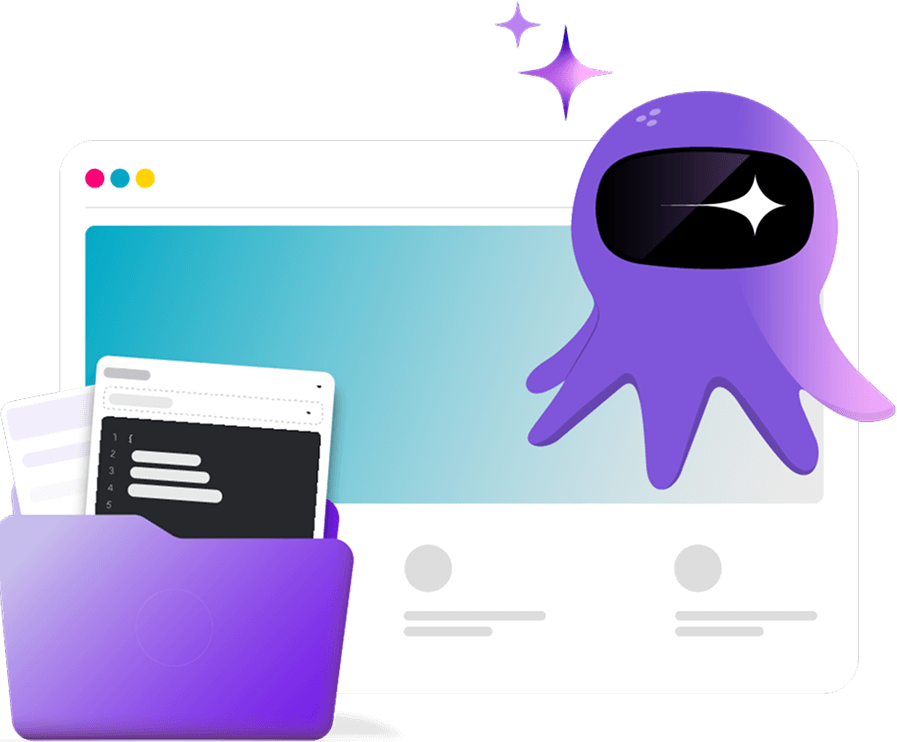Modern recruitment is changing fast. With a shifting talent market, remote hiring, and rising expectations for diversity, equity, and inclusion (DEI), structured and data-driven hiring is more important than ever. Although there are many candidate assessment benefits, some hiring teams still depend on outdated practices and gut instincts. That’s where modern recruitment starts to lean on candidate skills testing to achieve better results.
Table of Contents
This strategic tool includes a wide range of assessments that help businesses find the right people and turn hiring into a strong advantage. While faster hiring and lower costs are well-known benefits, there are deeper advantages that often go unnoticed, especially by top decision-makers.
In the sections below, we highlight 11 powerful benefits of using candidate assessments and explain why they are key to building a smarter, more innovative, and more dependable workforce.
TL;DR – Key Takeaways!
- Remove guesswork by using standard candidate tests to guide your hiring decisions.
- Use valid, reliable candidate assessment tools that measure real skills, not just what’s on a resume.
- Build strong, balanced teams by identifying skill gaps and overlaps early.
- Turn every assessment into a smart hiring tool that reveals deep talent insights.
- Focus on “culture add” instead of just culture fit to drive fresh team ideas.
- Stay legally compliant with fair, structured, and defensible candidate testing methods.
- Widen your talent pool and hire diverse candidates beyond resume filters.
- Improve offer acceptance rates with honest, fair, and clear recruitment practices.
- Lower early turnover and save on hiring costs with better-matched candidates.
- Save time and effort by automating early-stage screening and shortlisting.
- Let your leaders focus on strategy instead of sorting through resumes.
Benefits of Candidate Assessment Tests

1. Standardize Hiring Success
One of the most underrated benefits of using candidate assessment tests is building a measurable and repeatable talent hiring framework. With a structured, validated testing framework, companies can replicate successful hiring outcomes, reducing guesswork and building consistency in talent acquisition.
Leadership teams can then measure success across departments and roles, allowing HR to present tangible data on hiring performance. This strategic alignment improves decision-making and enhances workforce planning.

2. Match Skills to Real Roles
A resume may look impressive, but it often doesn’t reflect job readiness. A candidate assessment test goes deeper. It offers real-world simulations, case-based tasks, and scenario questions that reflect actual role demands.
This approach helps ensure valid and reliable assessments, where candidates are tested not on what they say they can do but on what they can actually deliver. As a result, it builds a stronger match between the hire and the job, which lowers the chances of mismatched expectations or a drop in performance.

3. Build Balanced Teams
Smart hiring goes beyond just ticking boxes. It focuses on matching skills and building teams where each person’s strengths support others. By reviewing results from pre-employment tests, companies can spot talent gaps or overlaps in their teams and make better hiring choices.
This strategic approach helps teams work together more smoothly, reduces silos, and boosts overall performance. It also gives leaders the tools to form diverse, high-performing teams that fit the needs of each project.
4. Creating a Talent Intelligence Layer
Many leaders view assessments as a tool for entry-level hiring only. However, when embedded across departments, candidate assessment tests become a strategic talent intelligence layer across the organization.
They help companies create detailed and useful profiles for both internal and external talent. As a result, HR teams can easily compare qualified candidates, support succession planning, and promote internal mobility, all by using data to guide every decision.

5. Hire for Culture Add, Not Just Fit
Cultural alignment is key to retention, but over-prioritizing culture fit often leads to homogeneous teams. A smarter approach is to assess for culture fit candidates who bring fresh perspectives while embracing shared values.
A well-structured cultural add test can help leaders avoid the trap of hiring “more of the same” while still protecting team cohesion. This practice promotes diversity in hiring without creating internal disruption.
Did You Know?
According to SHRM, 78% of companies using candidate assessment tests report a noticeable improvement in candidate experience and hiring accuracy.
6. Stay Legally Smart in Hiring
An often-overlooked benefit of candidate assessment is legal defensibility. When hiring decisions are challenged, whether internally or in court, having a structured candidate assessment test in place provides objective justification for hiring or rejection.
Recruitment tests that are valid and reliable help reduce the legal risks associated with discrimination claims. Businesses that operate in several jurisdictions need this layer of compliance.
7. Gain Competitive Talent Insights
When companies structure and analyze candidate data the right way, it turns into a powerful strategic asset. With thousands of assessment results coming in from different roles and regions, they can uncover insights about talent availability, salary expectations, and skill trends such as Gen Z hiring patterns.
As a result, they make smarter choices about when to expand, what roles to automate, or how to structure compensation, all through the lens of data-driven hiring.
Get the Shortest Way to Evaluate Talent Without Bias. Your Competitors Are Already Doing It. Are You?
Book A Demo8. Improving Offer Acceptance with Trust
When candidates feel the process is fair, transparent, and role-relevant, they are more likely to accept offers. A well-designed candidate assessment test conveys the organization’s seriousness and clarity about expectations.
This perceived professionalism leads to an improved candidate experience, a higher offer acceptance rate, and stronger employer branding, which are essential in competitive industries like tech, finance, and healthcare.
9. Cut Early Turnover
High turnover isn’t just about retention; it’s often a result of poor candidate-role fit. Recruitment assessments enable recruiters to test for skills, temperament, and work preferences early on. This means new hires walk in better prepared, more confident, and more engaged.
The result? You reduce turnover, lower first-year attrition, and retain top performers longer, protecting both morale and your bottom line.
Did You Know?
Companies using recruitment assessments are 24% more likely to build a high-performing team and reduce first-year attrition.
10. Open Doors for Diverse Talent
Traditional resumes and interviews often favor those with privileged backgrounds, degrees, or networks. But skills don’t always come with a pedigree. A candidate assessment test opens doors for non-traditional candidates, self-taught coders, career switchers, or remote workers.
This allows organizations to hire a more diverse team, tap into a broader talent pool, and expand their innovation capacity.
11. Freeing Up Leadership Time
Every minute you spend reviewing resumes or running unproductive interviews takes time away from strategy and growth. Instead, by using automated candidate assessments to evaluate both basic and advanced skills, you can focus on high-value tasks.
This approach saves time and resources. It also ensures your team only steps in when truly needed, usually during final interviews or key decision-making moments.

Next Steps? Switch to a Smarter, More Effective Way to Hire
In an age where people are the primary differentiator, treating hiring as a tactical function is a missed opportunity. For top leaders, the question is no longer whether we should use assessments but how strategically we are using them.
- Are we using hiring data to guide business decisions?
- Are we building repeatable, bias-resistant hiring processes?
- Are we aligning skills with roles and teams with missions?
Xobin answers “yes” to these questions and helps you in building a future-proof workforce.
If you’re exploring how to integrate candidate assessments into your hiring process across roles, regions, or departments, it’s worth considering Xobin. Our platform offers
- Custom skills-based assessments for different job roles
- Bulk test invites and instant results
- Interactive UI, gamified assessments, and real-time feedback
- AI-based evaluations, no manual intervention
- Structured, validated question banks with randomized questions
- GDPR-compliant with advanced AI proctoring and audit trails
- Cultural alignment and soft skills evaluations
- Executive-level dashboards for AI-driven actionable insights
Implementing a candidate assessment test doesn’t have to be disruptive. Xobin equips forward-thinking companies with everything needed to drive success in modern hiring, from pre-employment skills testing to executive-level analytics.
Explore how Xobin’s candidate assessment software can simplify hiring, deliver actionable insights, and help you build high-performing teams.
Visit https://xobin.com to learn more or book a personalized demo tailored to your hiring needs.
FAQs
1. What is a candidate assessment test, and why does it matter today?
A candidate assessment test is a structured tool used to evaluate job-relevant skills, behaviors, and cognitive abilities. It matters more than ever because traditional hiring methods can’t keep pace with today’s fast, remote, and high-stakes recruitment demands. These tests offer valid and reliable assessments that reduce guesswork and drive better hiring decisions.
2. Can assessments really help reduce early employee turnover?
Absolutely. Many early exits happen due to a mismatch in skills or expectations. Pre-hire assessments ensure the candidate is job-ready from day one, leading to a better candidate experience, increased engagement, and a noticeable reduction in turnover.
3. What should I look for in a candidate assessment platform?
Leaders should prioritize platforms offering customization, role-based tests, culture add tests, AI evaluations, compliance, and analytics. A candidate assessment tool should not just test skills; it should guide smarter hiring decisions and help improve offer acceptance rate and long-term team performance.
4. What is the main benefit of using a candidate assessment test in hiring?
The main benefit is its ability to create a standardized, data-driven, and unbiased hiring process that improves the quality of hire, reduces turnover, and enhances offer acceptance rates.
5. How do candidate assessment tests reduce time to hire?
They automate early screening by validating skills upfront, helping recruiters identify qualified candidates faster, saving time and resources for strategic tasks.
6. Can candidate assessments support diversity in hiring?
Yes. Assessments standardize evaluation, reducing human error and hiring bias. They open the door to diversity in hiring by focusing on skills over background, helping you hire a more diverse team that thrives on inclusion and innovation.







